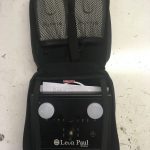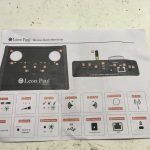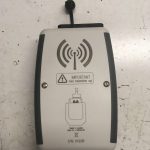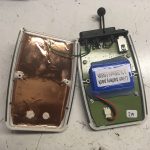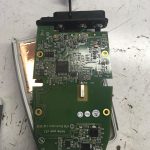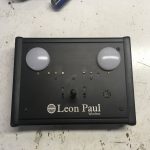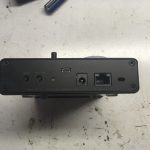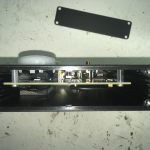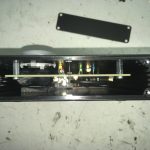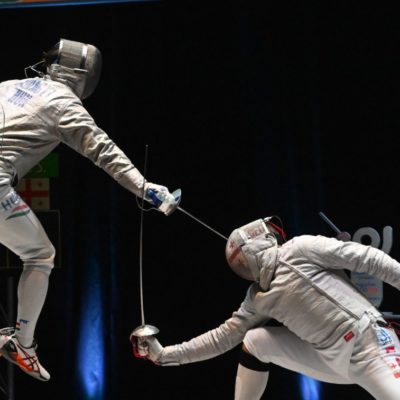Around April of this year (2017), Leon Paul released an unexpected but potentially exciting new product: their Wireless Fencing offering. Leon Paul already has an entry into the wireless territory with their Hitmate, but that is an older and epee-only product. The Wireless Fencing offering has been in the works for many years now, with first inklings being noted in an article written in 2015.
Foil and Epee Only
The primary thing to note on the Wireless Fencing offering is that its only for Foil and Epee. The box itself, though, does have a switch position for saber and previous discussion circled around all three weapons, so it is very possible that a firmware update or other upgrade in the future will enable saber as an option. However, a very significant difference in this box and similar offerings in the past is that this box will correctly ground on a metal strip without any extra setup or configuration (provided the strip itself is electrically grounded).
Features
The Wireless Fencing system meets FIE specs and can (likely) be firmware updated when timings change. Both the base station and the fencer packs are charged by micro USB. The base station has a 50 hour battery life, and the packs are 35 hours each. The system is based on Bluetooth (or a 2.4Ghz variant), so it can be used anywhere. The system can support up to 100 (or so) boxes at a time, which should be enough for almost any situation. The packs themselves come synced with the base station by default, but they can be re-synced with other stations if necessary (when replacing a broken pack, for example). The base station is fairly light and should be easy to mount to any wall or surface required. A connection for repeater lights is also provided.
Basic Usage
Just like learning to use the reel system for the first time, this system takes a little practice. To start, the body cord connectors must be in your back pocket when fencing. This is because the system is capacitance based. It requires close proximity to the skin, so hooking it on to your D ring won’t quite make the cut.
The second is the calibration. Fencers are used to the “test valid” process. The calibration process for the Wireless Fencing system is slightly different, but different enough to create potential issues. For both weapons, if you aren’t calibrated, a blue light will show up on the box and no touches can be scored. One fencer at a time must calibrate, and its generally not recommended to do anything other than calibration during calibration time. At all. Neither fencer should be leaning on a wall, sitting down, holding their weapon, etc.. Nothing that could throw off the calibration process.
To calibrate for foil, a fencer must hit their opponent on valid target with two slow, deliberate hits in a row. To calibrate for epee, a fencer must hit their opponent on their bell guard with two, deliberate hits in a row. For both weapons, the hits must really be fairly slow, pressing the tip onto the calibration area. This requires some specific highlighting because most fencers are used to doing quick pokes to test, particularly in epee. Ding, ding, done. That doesn’t work for calibration. To calibrate epees, the full tip must hit the bell and fully depress before releasing. Get the full surface area of the tip in contact with the bell if you can.
Why is this important? Because the machine takes a fresh reading each time it calibrates, and any variations (like, say, a small bit of rust on your bell guard or a not-quite-dead-but-nearly-dead part of your lame) can throw off the calibration process.
And that’s it! Fence away on your new wireless system.
Fencing.net Testing
We tested the Wireless Fencing system over the course of numerous practices in a few different situations. In particular, we gave the system to people who had never seen it before to see how well they could figure it out in an unsupervised setting, and we also tested it with a group of people fully supervised by someone who had used the system before.
Generally speaking, the people who had never used the system before had issues. Some were readily identifiable, while others were not. For example, without fully reading the instructions, several fencers hooked the packs onto their D rings instead of putting them in their back pocket. Some people reported intermittent scoring issues, as well as intermittent consistency with the grounding of the piste.
However, almost none of those issues surfaced under controlled, supervised bouting. It is our strong suspicion that the bulk of the issues seen were caused by incorrect calibration or usage of the Wireless System.
Which isn’t to say that the system is perfect. For example, a lame with dead spots or other inconsistencies will cause issues with calibration and scoring. An epee body cord with corrosion will cause the same issues. Both of these are issues that you won’t see with the normal wired system. For people with good working equipment, this isn’t a problem. But if a club has loaner equipment that gets beaten up a bit, this could be problematic. Similarly, a grounded strip that isn’t truly electrically grounded can also cause issues. But these are all known issues, not phantom issues or general inconsistencies.
Teardown Photos
We did an incomplete teardown on the system we had in hand. Incomplete because there were some limitations – we wanted to keep the box in working order, so we went as far as we could until we had to do some permanent or risky actions to go further. Please see the teardown photos below!
Final Review Of The Leon Paul Wireless Fencing System
The Leon Paul Wireless Fencing system is a different beast. It operates differently than the wired systems, providing different benefits and issues than our current standard. And it is also different from the World Cup level wireless systems that require conductive undershirts to ensure consistency. Outside of the VSM with VSM reels, this is the cheapest strip setup on the market today, at approximately $1000 USD (depending on exchange rate and where it is ordered). Comparable wired systems run in the same ballpark (~$1200) and the World Cup systems run several thousand dollars plus the conductive undershirts are added costs put on the fencers.
Due to the occasional inconsistencies (which have minimal impact on regular club bouting), these are probably not tournament ready boxes right now. So if you plan on running sanctioned events at your club, these are not the machines for you. Similarly, if your club has a closet full of lames with dead spots, this system also likely will not work for you. (unless you’re willing to replace your lames!)
However, if you’re looking for a convenient budget daily use box, this system works quite well. In particular, there are a few use cases that this system seems to work extremely well for: shared spaces, traveling clubs, and/or satellite locations. If you have to constantly pack up your strips either to travel with them (to satellite clubs) or because your space is shared (collegiate clubs fencing on basketball courts), this is a great one to pick up.
The Leon Paul Wireless Fencing system feels like the first real commercially available and generally affordable option for fencing clubs. I look forward to the future of wireless fencing in the form of refinements from Leon Paul and any other vendor out there looking to throw their hat in the ring. With this product, Leon Paul has opened up the market and shown its possible to produce a viable product in the space.



